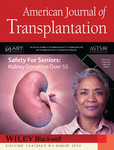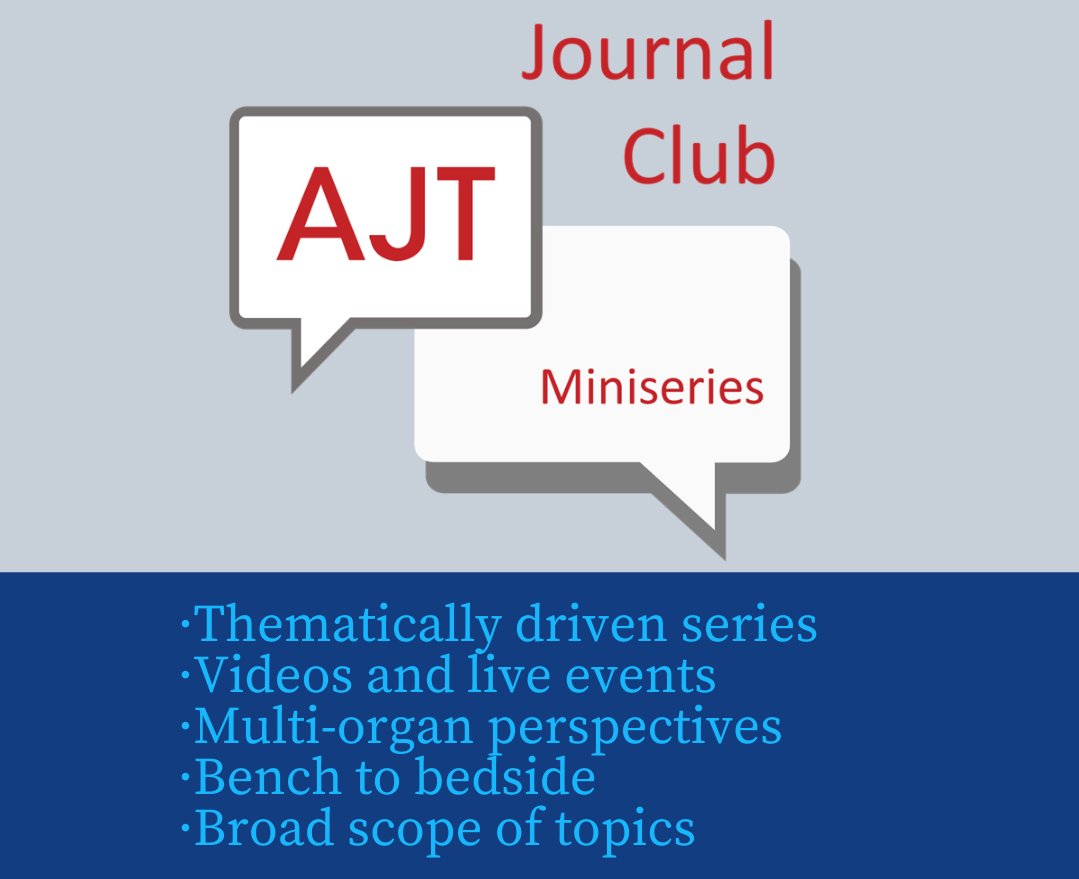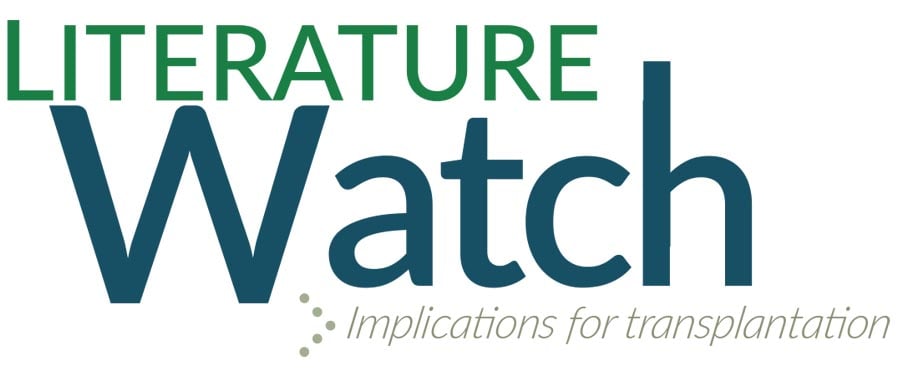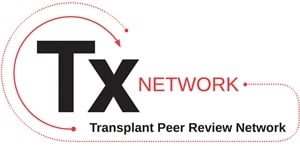Journal list menu
Export Citations
Download PDFs
Cover Image
American Journal of Transplantation: Volume 14, Number 8, August 2014
- First Published: 17 July 2014
On the cover this month: Donor safety is arguably the most critical consideration in organ transplantation. While live donor kidney transplantation has advanced based on the premise that healthy donors are not disadvantaged with regard to long-term mortality, this assumption has not been specifically examined as it relates to older donors, and this is increasingly relevant as the population in general ages. This month, Reese et al (page 1853) examine the long-term survival of donors over the age of 55 and show that long-term mortality is not adversely affected. This provides direct evidence as to the relative safety of kidney donation for healthy older patients and validates current restrictive practices limiting donation to patients without significant comorbidities. Also, see the online version of the Iyer et al article (page 1744) on DCD heart protection for two accompanying videos. Cover design by Michael Konomos.
The AJT Report
The AJT Report
- Pages: 1711-1712
- First Published: 17 July 2014
Experts in transplantation and related medical fields have a common goal of increasing organ donation in the United States by 1,000 transplants per year for the next five years. This issue of “The AJT Report” looks at how this committee came together, and what the goal will mean for the field. Also this month, we review how a policy interpretation from CMS is impacting offsite organ recovery.
Literature Watch
Literature Watch Implications for transplantation
- Page: 1713
- First Published: 17 July 2014
Understanding the immunoregulatory roles of mTOR complexes in transplantation may prove valuable in the design of novel therapeutic strategies.
Editorials
Quantifying Risk of Kidney Donation: The Truth Is Not Out There (Yet)
- Pages: 1715-1716
- First Published: 27 May 2014
This editorial offers a counterpoint to the findings of increased mortality in living kidney donors in a study by Mjøen et al that has been widely discussed in the transplant community.
Belatacept: Is There BENEFIT for Liver Transplantation Too?
- Pages: 1717-1718
- First Published: 17 July 2014
The results of the multicenter belatacept liver transplant trial disappoint with respect to safety and efficacy, and new approaches will be required before this agent plays a role in liver transplant immunosuppression. See article by Klintmalm et al on page 1817.
Everolimus in Heart Transplantation: Does It Finally Have a Home?
- Pages: 1719-1720
- First Published: 10 July 2014
This editorial approves the use of everolimus to wean calcineurin inhibitors (by 7–11 weeks postoperative) as safe and effective with improved first-year renal function and reduced intimal thickness by intravascular ultrasound. See article by Andreassen et al on page 1828.
Alemtuzumab Induction in Lung Transplantation: Time to Move On?
- Pages: 1721-1722
- First Published: 10 July 2014
This editorial puts into perspective the findings of the first randomized, controlled trial examining alemtuzumab induction for lung transplantation, and highlights the challenges encountered with alemtuzumab induction in other solid organs. See article by Jaksch et al on page 1839.
Comprehensive Review
Big Data in Organ Transplantation: Registries and Administrative Claims
- Pages: 1723-1730
- First Published: 07 July 2014
This review discusses large national datasets that have been used to address research questions in organ transplantation, with a description of available datasets and consideration of proper study design.
Minireview
Autophagy: Basic Principles and Relevance to Transplant Immunity
- Pages: 1731-1739
- First Published: 16 June 2014
The process of autophagy was originally described in cells under starvation, but numerous studies now establish the link with most cellular stress-response pathways, including those involved in controlling immune response and inflammation.
Personal Viewpoint
Organ Transplantation for Nonresidents of the United States: A Policy for Transparency
- Pages: 1740-1743
- First Published: 19 May 2014
This viewpoint supports increased transparency of national practices by reviewing the first 22 months of data collected regarding noncitizens and nonresidents who traveled to the United States for purposes of transplantation.
Original Articles
Basic Science
Increasing the Tolerance of DCD Hearts to Warm Ischemia by Pharmacological Postconditioning
- Pages: 1744-1752
- First Published: 08 July 2014
In this study of cardiac donation after circulatory death, supplementation of cardioplegic flush solution with a combination of erythropoietin, glyceryl trinitrate, and zoniporide significantly extends the tolerability of the porcine heart to warm ischemia following withdrawal of life support. See online supporting information for supplemental video content.
Graft-Derived CCL2 Increases Graft Injury During Antibody-Mediated Rejection of Cardiac Allografts
- Pages: 1753-1764
- First Published: 08 July 2014
This study investigating the role of macrophage functions in antibody-mediated rejection of heart allografts in a mouse model indicates that the absence of allograft CCL2 expression markedly reduces antidonor antibodyinduced allograft inflammation including the infiltration of classically activated macrophages.
HMGB1 Is Involved in Chronic Rejection of Cardiac Allograft via Promoting Inflammatory-Like mDCs
- Pages: 1765-1777
- First Published: 01 July 2014
Using a single MHC class II–mismatched mouse cardiac transplantation model, the authors find that blockade of high-mobility group box 1 ameliorated chronic rejection and cardiac allograft vasculopathy by decreasing the number and frequency of matured dendritic cells.
RIPK3-Mediated Necroptosis Regulates Cardiac Allograft Rejection
- Pages: 1778-1790
- First Published: 01 July 2014
This study demonstrates that receptor-interacting protein kinase 3 regulates necroptotic death, danger molecule release, and cardiac allograft survival.
DAP12 Deficiency in Liver Allografts Results in Enhanced Donor DC Migration, Augmented Effector T Cell Responses and Abrogation of Transplant Tolerance
- Pages: 1791-1805
- First Published: 16 June 2014
The authors' data suggest that expression of the transmembrane immunoadaptor DNAX-activating protein of 12 kDa in mouse liver allografts regulates donor dendritic cell migration to host lymphoid tissue, down-modulates effector T cell responses, and promotes transplant tolerance.
Somatostatin Therapy Protects Porcine Livers in Small-for-Size Liver Transplantation
- Pages: 1806-1816
- First Published: 16 June 2014
The authors show that perioperative somatostatin treatment improves portal hemodynamic parameters, cellular injury, and outcome in a porcine model of small-for-size liver transplantation, and present in vitro experiments demonstrating that somatostatin administration is directly protective to hepatic stellate cells.
Clinical Science
Belatacept-Based Immunosuppression in De Novo Liver Transplant Recipients: 1-Year Experience From a Phase II Randomized Study
- Pages: 1817-1827
- First Published: 17 July 2014
This study reports results of an exploratory phase II trial in adult liver transplant recipients to evaluate belatacept compared with tacrolimus-based immunosuppression, concluding that a safe and effective belatacept regimen for use in liver transplant patients is not yet identified. See editorial by Knechtle and Adams on page 1717.
Everolimus Initiation and Early Calcineurin Inhibitor Withdrawal in Heart Transplant Recipients: A Randomized Trial
- Pages: 1828-1838
- First Published: 10 July 2014
This randomized, open-label trial in 115 de novo heart transplant recipients shows that low-exposure everolimus (3–6 ng/mL) combined with reduced-exposure cyclosporine withdrawn at 7–11 weeks results in significantly better renal function at 12 months versus standard-exposure cyclosporine. See editorial by Kobashigawa and Zuckerman on page 1719.
Alemtuzumab in Lung Transplantation: An Open-Label, Randomized, Prospective Single Center Study
- Pages: 1839-1845
- First Published: 10 July 2014
Alemtuzumab induction therapy after lung transplantation in combination with reduced maintenance immunosuppression significantly reduces higher grade rejection rates, and shows comparable survival and BOS rates to standard immunosuppressive therapy without increasing incidence of infectious complications or malignancies. See editorial by Todd and Palmer on page 1721.
Morbidity and Mortality of Live Lung Donation: Results From the RELIVE Study
- Pages: 1846-1852
- First Published: 08 July 2014
This retrospective study of 369 live lung donors shows an 18% short-term incidence of serious complications and no short- or long-term mortality, and suggests a need for long-term evaluation of morbidities and other important outcomes.
Mortality and Cardiovascular Disease Among Older Live Kidney Donors
- Pages: 1853-1861
- First Published: 09 July 2014
In this matched cohort study, 3,368 older (≥55 years) live kidney donors in the United States have no difference in mortality, cardiovascular disease, or diabetes rates compared to healthy older nondonors.
Home-Based Family Intervention Increases Knowledge, Communication and Living Donation Rates: A Randomized Controlled Trial
- Pages: 1862-1869
- First Published: 16 June 2014
A home-based family intervention is effective in increasing living donation rates and improving well-informed decision making among patients and their families regarding renal replacement therapies.
Frailty Predicts Waitlist Mortality in Liver Transplant Candidates
- Pages: 1870-1879
- First Published: 16 June 2014
In this study, the researchers report that frailty, a validated geriatric construct of increased vulnerability to physiologic stressors, is highly prevalent in patients with cirrhosis awaiting liver transplantation and strongly predicts waitlist mortality, demonstrating the applicability and importance of the frailty construct in this population.
Defective Glucagon Secretion During Hypoglycemia After Intrahepatic But Not Nonhepatic Islet Autotransplantation
- Pages: 1880-1886
- First Published: 08 July 2014
Transplantation of pancreatic autoislets in both intrahepatic and nonhepatic sites in humans preserves glucagon and symptom responses to hypoglycemia, whereas use of the intrahepatic site alone does not.
MRSA and VRE Colonization in Solid Organ Transplantation: A Meta-Analysis of Published Studies
- Pages: 1887-1894
- First Published: 08 July 2014
This meta-analysis reviews the prevalence and significance of methicillin-resistant Staphylococcus aureus and vancomycin-resistant Enterococcus colonization in solid organ transplantation.
Brief Communications
Reduced Binding of Human Antibodies to Cells From GGTA1/CMAH KO Pigs
- Pages: 1895-1900
- First Published: 06 June 2014
Crossmatch analysis of human antibody binding to cells from pigs genetically modified for xenotransplantation is similar to allogeneic cells, lower than chimpanzee cells, and unaffected by age, gender, or blood type.
Clostridium difficile Infection in Liver Transplant Recipients: A Retrospective Study of Rates, Risk Factors and Outcomes
- Pages: 1901-1907
- First Published: 05 June 2014
A retrospective cohort study of Clostridium difficile infection in 970 liver transplant recipients finds high prevalence (18.9%), recurrence (16.9%), and relapse (9.7%) rates, and significantly higher all-cause mortality.
Current Prevention Strategies Against Cytomegalovirus in the Studies in Pediatric Liver Transplantation (SPLIT) Centers
- Pages: 1908-1911
- First Published: 05 June 2014
A survey of 29 centers participating in the North American Studies in Pediatric Liver Transplantation reveals that prophylaxis predominates cytomegalovirus prevention strategies, although the duration of prophylaxis ranges broadly, providing the opportunity for comparative effectiveness evaluation to assess optimal duration of prophylaxis in this indication.
Transcriptional Profiling of Belatacept and Calcineurin Inhibitor Therapy in Renal Allograft Recipients
- Pages: 1912-1921
- First Published: 20 June 2014
This gene expression profiling substudy of BENEFIT and BENEFIT-EXT identifies gene sets differentially expressed at 12 months posttransplant in kidney biopsies of belatacept- versus cyclosporine-treated patients and provides mechanistic insights into the reduced chronic allograft injury and improved renal function observed with belatacept treatment.
External Validation of the Estimated Posttransplant Survival Score for Allocation of Deceased Donor Kidneys in the United States
- Pages: 1922-1926
- First Published: 05 June 2014
The estimated posttransplant survival score, which will be used to prioritize allocation of the best 20% of deceased donor kidneys in the United States, is moderately good at discriminating posttransplant survival of adult kidney-only transplant recipients, even in an external dataset with differing donor, recipient, and allocation system characteristics.
Case Reports
Extra-Anatomic Stent (EAS) as a Salvage Procedure for Transplant Ureteric Stricture
- Pages: 1927-1930
- First Published: 01 July 2014
The authors describe the insertion of a novel extra-anatomic stent in a 65-year-old male renal transplant patient in whom all conventional methods of treatment (endo-urological and surgical) failed to bypass a complete ureteric obstruction.
Laparoscopic Kidney Transplant by Extra Peritoneal Approach: The Safe Transition From Laboratory to the Clinic
- Pages: 1931-1936
- First Published: 08 July 2014
The authors report a successful laparoscopic kidney transplant performed by an extra-peritoneal approach.
Reports From the CDC: MMWR
Measles—United States, January 1–May 23, 2014
- Pages: 1937-1940
- First Published: 17 July 2014
Measles is on the rise in the United States, posing a potential hazard for unvaccinated transplant recipients.
Images in Transplantation
CME
Bovine Pericardium Diaphragm Repair of Diaphragmatic Hernia After LVAD Explantation and Heart Transplantation
- Pages: 1941-1943
- First Published: 17 July 2014
Letters to the Editor
A Regulated System of Incentives for Living Kidney Donation: It Is Time for Opposing Groups to Have a Meaningful Dialogue!
- Pages: 1944-1945
- First Published: 01 July 2014
Role of Left Ventricular Assist Devices in Assessment of Patients for Combined Heart–Kidney Transplantation
- Pages: 1946-1947
- First Published: 08 July 2014
Response to Letter Regarding Article Entitled “Heart and Combined Heart–Kidney Transplantation in Patients With Concomitant Renal Insufficiency and End-Stage Heart Failure”
- Pages: 1948-1949
- First Published: 08 July 2014










.jpg)
